Table of Contents
The Chitta Katha Lake is a gorgeous body of water in the Shounter Valley of Azad Kashmir. It rises to 13,500 feet (4,115 meters) above sea level. The name is Chitta Katha comes from the region’s topography. It means “white stream” in the local dialect.
The lake Chita Katha Sar originates from the flow of the Chitta Katha Stream, which originates on Mount Harri Parbat. This mountain is a sacred site for Hindu believers who see it as Lord Shiva’s eternal sanctuary and “The Kailash.” A challenging yet beautiful and picturesque trek may reach Chita Kati Lake.
The lake’s breathtaking beauty and supernatural magnetism invite the visitors to come soon after. The jeep track begins in Kel and ends in Domail Bala. It is a 20-kilometer (12-mile) long, rough shingle road. The route starts with a 5-kilometer (3.1 miles) extended lush green beautiful area, followed by a 5 5-kilometer (3.1 miles) trek through the trees and over snow-capped mountains.
The lake’s base camp is Kel. A 20-kilometer (12 mi) jeep track and a 5-kilometer (3.1 mi) trek lead to the lake, which is accessible from Kel by a 20-kilometer (12 mi) hiking route. The Lake of Colors is situated at the base camp in Kel.
Top Attraction of Chitta Katha Lake
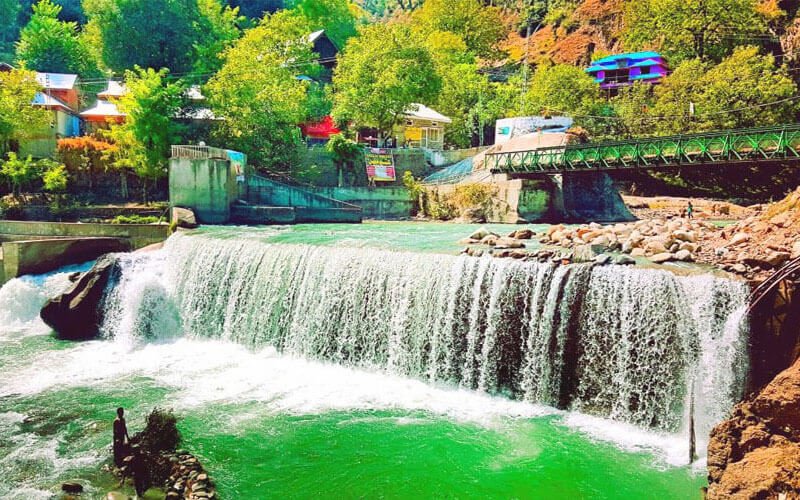
Following are the main tourist attraction of Chitta Katha Lake, which tourists from all over the world attract.
Dhani waterfall
Kuttan
Jagran resort
Kieran
Kel
Domain
Counter
Spoon lake
Chita Khatha lake
Possible Eternity
Day 01:
Leave Islamabad at 1 am in a scheduled car. Muzaffarabad Breakfast, Lunch at Keran. Ride a Jeep to Upper Domail and seek out Kel. Stay the night at camps in Upper Domain.
Day 02:
Upper Domail’s breakfast is the main meal. No lunch will be served today, but daypacks will be distributed before the trekking starts. Now, Dinner and Night stay in camps at Dak-1/Dak-2.
Day 03:
Breakfast at Dak-1/Dak-2. Walk to the Chitta Katha lake. Rather than providing lunch, daypacks will be distributed this day before the trekking begins. After lunch, you’ll set up camp on the lake’s bank. The dinner and night will stay in camps on the lake’s shore.
Day 04:
At Chitta Katha Lake, stop for breakfast and relax on the deck. Take a stroll down to the lower Domain. Back to Upper Domail for lunch. Back to Kel on a Jeep. After dinner and the night in a hotel, you’ll return to Kel.)
Day 05:
Start your day at Kel with a hearty breakfast. Then, begin the return journey to Islamabad. Lunch in Keran/Muzaffarabad. Arrive in Islamabad.
Essential logistic to Bring to Chitta Katha Lake
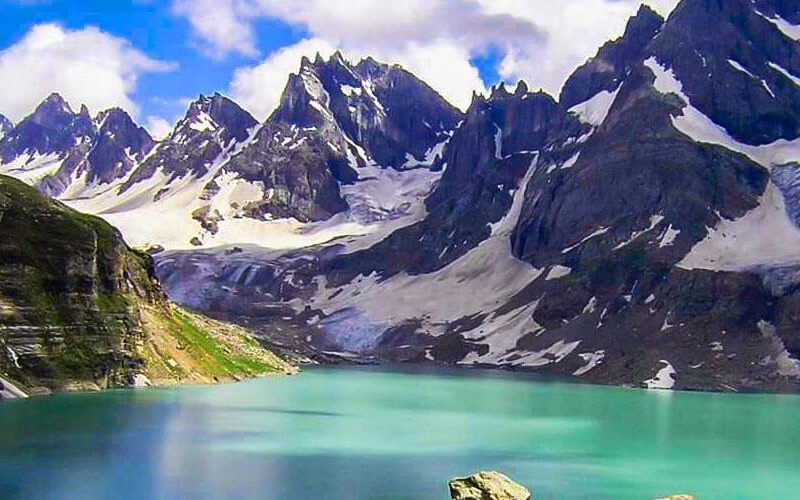
You need the following items during your whole journey to Chitta Katha Lake.
- Warm clothes in layers – If you plan on trekking in cold weather, including while wearing multiple layers (besides your base layer), then down is not an option. It’s important to note that quality down can be expensive and may only last for a few seasons, depending on how you use it and the type of usage.
- Shoes with good traction are recommended.
- Make sure you have enough shade and sunblock.
- Medicines, first-aid supplies, and other emergency essentials should be available with you.
- You’ll need the items above, as well as anything that aids you to recoup your energy while trekking.
- A torch.
- A multi-functional knife with several blade edges and shapes.
Purchasing Equipment
You can purchase your gear, equipment, and food from Kel or Shantur Valley. Many local markets buy tents, sleeping bags, basic toiletries, hiking skies water bottles, and canned food. Many local families can cook food for you.
How to Reach Chitta Katha Lake from Islamabad
You might think of this journey as consisting of three primary sections:
- Islamabad to Kel – in Azad Kashmir – by car. (approximately 10-11 hours)
- Kel to Shonter – by hired 4×4 jeep. (about 2.5 hours)
- Shooter to the lake – by foot (trekking). (about 9-12 hours)
Islamabad to Kel
You can depart in your vehicle at any time of day or night. If you can drive straight, it will take around 11 hours to get to Kel. The total distance is approximately 320 kilometers. You may travel from Islamabad to Abbottabad, Garhi Habibullah, Muzaffarabad, Athmuqam, Karen, or Sharda via the route of Islamabad-Murree-Muzaffarabad-Athmuqam-Karen-Sharda.
The times spent on both ways are similar; however, check the road conditions before going. Following the completion of Muzaffarabad, there may be road works or landslides in the region. Any automobile will suffice if you can drive slowly when you see a rise ahead with an asphalt or water flow fracture. If you prefer to avoid waiting, consider parking your vehicle in Karen or Sharda and hiring a local taxi.

There is no cell phone coverage after Muzaffarabad for approximately 100 kilometers. Therefore, PCOs may be utilized anywhere between Kel and the Pakistan-Afghanistan border.
After Muzaffarabad, you’ll have many more options for food and lodging. Choices may be limited, however. You can get petrol from local merchants from Karen, which is relatively safe. During your journey, you will come across breathtaking beauty.
There are meadows, rushing water streams, rustic homes made of wood, and lovely villages. You might stay the night at Sharda, an hour and 20 minutes from Kel. We stayed at a hotel that charged us Rs. 1000 (US 10) per room, which was very clean. The weather will be chilly at night, so bring your warm clothes.
Kel to Shonter:
You’ll need to rent a 4×4 vehicle from Kel.
Important Tip:
Hire a local Jeep driven by a local driver, regardless of how good your 4WD is or how smoothly you move. The road is extremely rough and hazardous. However, the drivers are experienced, and there should be no issues with frightened passengers. Every day, more than 50 automobiles travel up and down this route.
There are two types of jeeps to choose from: a big one that seats 8-10 people and costs around Rs 6000 (US 60) for a round trip, and a small one that seats 5-6 people and is 1000Rs less. Open-top vehicles, such as Jeeps, can get dusty.
The journey takes 2.5 hours; the return trip is a little longer at 2 hours. You may signal the driver when you want him to fetch you for the return journey. If you don’t arrive on time, you’ll be charged for his delay. If you leave one day later than planned, the total is up to Rs 9000.
Read More: How to plan a tour of Neelum Valley Kashmir? Complete Travel Guide & Information.
Hire A Guide:
At the end of the trek, you’ll need to off-load at the base camp, about 2.5 hours from Kel (GPS 34.94/74.46). It’s a meadow with three to four large tents and a water stream. You may rent out guides, ponies, tents, and sleeping bags, among other items.
However, they charge more for expediting services like arranging transportation, accommodation, and meals. For example, a guide would cost $1500 per day; a pony would be $2500 per day; a tent would set you back another $1500 each day; and so on. However, you may save money if you purchase many things from them.
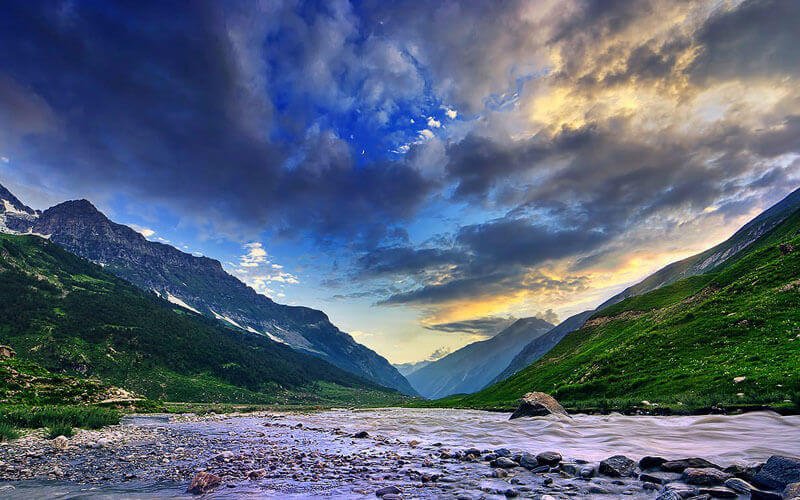
You may also continue to the Upper DoMel (Meeting Place of 2 Streams), approximately 10 minutes from the base camp (34.96/74.47). Upper Domel offers similar services as well. We advise you to stay at base camp since the guides there are from the nomadic families moving throughout the track you’ll follow.
If you walk from Upper Domel, expect 20-25 minutes to your journey. It’s a significant matter to preserve muscle energy when you’re outdoors. Shooter Lake, about 25 minutes by car from the base camp, is for lake enthusiasts. It is pretty decent.
Hiring a guide if you are new to the area will be more convenient. That is because the trek isn’t well-defined, with numerous diversions. In numerous situations, you may get lost.
Carry Your Tent & Sleeping Bag:
The guides can also help you carry some of your belongings. If you have your tents and sleeping bags, you may request that they be held (on a horse perhaps, or in the hands of locals known to him) to the area where you are likely to camp for the night.
The cost should not be more than Rs. 2000. If you don’t have them, you may utilize tents and sleeping bags provided by the tour guide. Some people might not be happy with them. For food provision, the nomad families we previously spoke of may also supply you with blankets and thin mattresses for a reasonable price.
Last, they may or may not be to your liking. If you’re a seasoned hiker, you might carry your tent and sleeping bag in the back of your backpack. However, remember that this route is not for the faint of heart. It is, in at least three locations, quite hazardous.
The terrain is quite tricky, and the course requires skill levels between hiking and mountaineering. So prepare yourself. My advice is to avoid or use light backpacks.
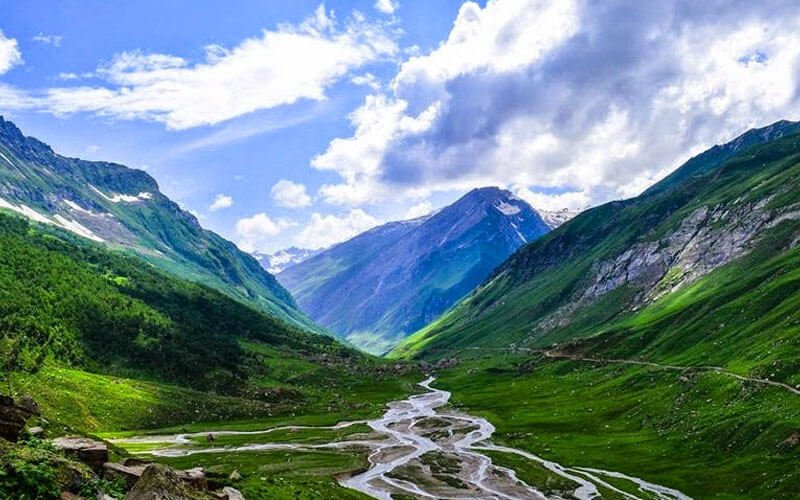
Domail Valley:
A valley known as Lower Domail Village has just emerged. From this vantage point, the magnificent vista of the Hari Parbat Mountains is visible. Unfortunately, the S.com signals have stopped delivering, but an incredible experience at this time was there.
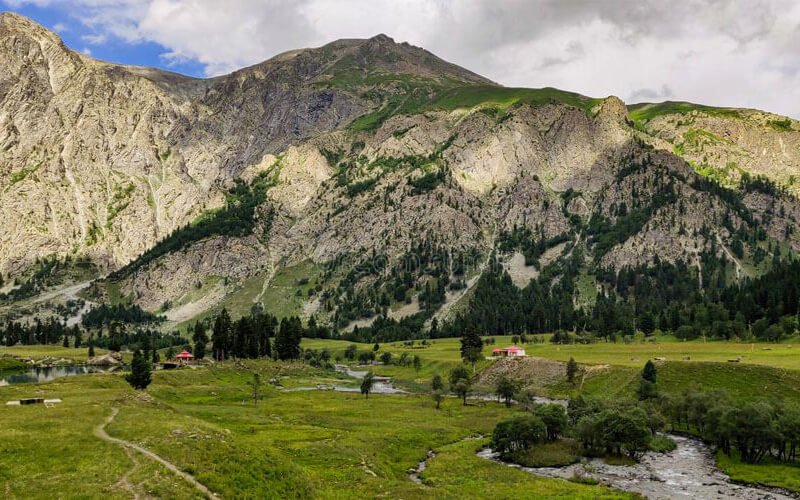
Sarwali Peak and Hari Parbat:
Please pay attention, and we are going to share some important geographies. Sarwali Peak is the highest point in Azad Kashmir, also known as Dabbar Peak and Toshe Ri. The highest point in the state is Hari Parbat, which reaches a height of 16,500 feet and includes a significant technical climb.
Notably, while these two peaks are in separate Kashmir territories, they are considered by many to be the twin peaks of Siachen. Mountain Science says these two mountains are little “Nanga Parbat.” Yes, the complicated mess is a broad range. The Sarwali and Hari Parbat peaks are in the Nanga Parbati range, which borders Azad Kashmir.
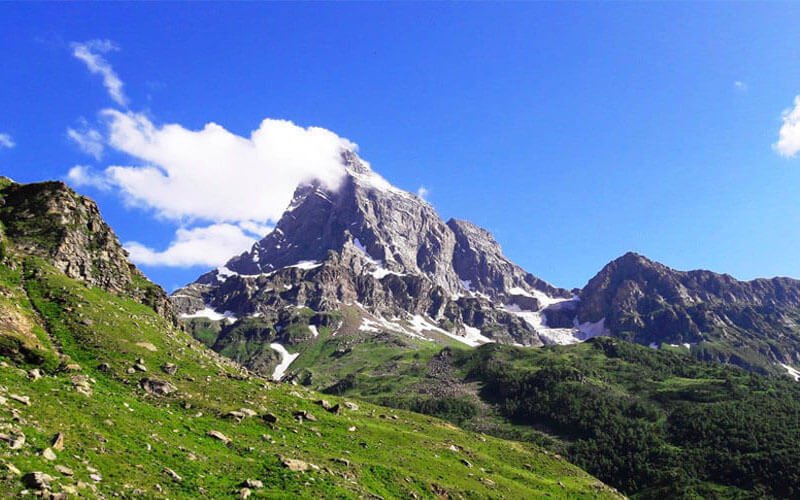
Nangi Mali Mountain:
“This is a Nangi Mali Mountain in front of us. Ruby mines are still operational today due to their rich veins of rubies. Ruby or red Yaqoot stones are valuable gemstones.” It looked like a different mountain, shining so beautifully yet ungainly and treeless.
It was said that some businesses had mined the hill and were extracting ruby. The route eventually came to an end. A vertical wall stood on one side, with the waterfall on the other.
There was too much of a gradient. Aside from the feet, hands were climbing as well. A lovely view of “Nangi Mali.” emerged in this location. The colors of fall are in the background of the trees.
According to many websites, this route takes 5 hours “for the experienced hiker – for others it might take longer.” But in our opinion, this track has a proven record of 5 hours. An average person should expect to spend 9-12 hours on the journey.
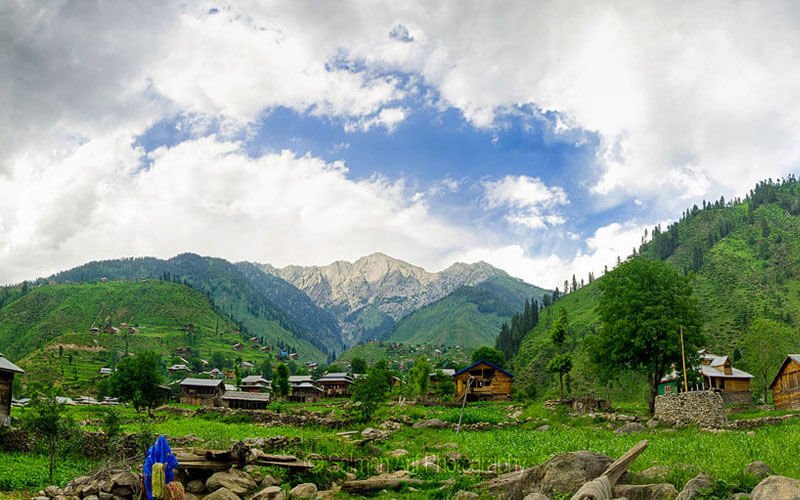
Consider the hikers’ path to be made up of five components:
Leg 1. Base Camp to DAK 1.
Leg 2. DAK 1 to DAK 2.
Leg 3. DAK 2 to the foot of the giant waterfall.
Leg 4. Foot of waterfall to meadows/glaciers before the lake.
Leg 5. To the lake, take a stroll along the meadows/ glaciers and see Hari Parbat peak towering above you.
Leg 1 – Base Camp to DAK 1
There are 2 paths to the lake once you’ve crossed the river via a wooden bridge and entered a hamlet beyond. From there, you may take the Stony Ridge route, which goes through a rocky area and along a valley named DAK 1. Taking the ridge crest is relatively time-consuming – around 4-6 hours.
It would help if you also navigated a steep rocky ridge with a gradient of approximately 100 meters. You must rest several times and recoup depending on your muscles’ readiness. There is a stream at the beginning of this route, so be sure to bring enough water.
En route, you’ll come across plants with a tiny crimson berry called Khun Murch. It has an intense strawberry taste and quickens your energy levels. Look for them along the way.
On a scale of 1 to 10, where one indicates that trekking without the proper equipment is exceptionally hazardous, I rate this path a 6.5. For comparison’s sake, Islamabad Trail 3 is graded 0/10.
Important:
The second option is to travel along the stream from DAK 1 and 2, Route Two. This route is shorter and steeper, taking around 3-3.5 hours to complete. This course follows the waterway almost the entire length, ensuring plenty of water.
It is the most dangerous, and we give it an 8 rating. Before you reach the top of the falls, the final stretch is a nearly vertical sloping cliff to climb – approximately 250 feet and a very tight green trail, around 300 meters.
This one is only for some because they have a big backpack. If it’s raining, the road becomes much more dangerous. Stop completely until the rain has cleared. If the rocky ridges appear to be slippery, be doubly cautious. Along both routes, you will discover a wide variety of plants.
Depending on when you arrive and how tired you are, you should pitch a tent for the night at DAK 1 or DAK 2. The nomads here can cook for you and provide tents and sleeping arrangements that are reasonably priced.
Leg 2 – DAK 1 to DAK 2
DAK 2 can be viewed from DAK 1; the distance is likely less than a kilometer. It’s a long, steep climb on a green mountain that ends with a steep glacier across the stream. Although this glacier appears safe while climbing, it can be hazardous when returning.
So please do your best. This phase will take you between 15 and 30 minutes to complete. So why is this a leg? Because of your choice about where to stay — DAK 1 or DAK 2. The top of the mountain, windy and chilly and more private than DAK 2, does not have water flowing around it.
At the bottom of the slope, where we are standing, a beautiful little creek flows down into the valley. Many water streams flow about on both sides of the stream and on either bank. The DAK 1 site has excellent photo opportunities because it’s in the valley.
Leg 3 – DAK 2 to the foot of the large waterfall
If you camped at DAK 1 or 2, depart as soon as feasible so that you may spend a lot of time there on the lake. The vast majority of visitors leave at 6 am. DAK 1 to the lake will take around 4-5 hours. Nowhere else in the world has nature been given this kind of care.
The untouched beauty of the area is hard to explain. Clouds whirling around, virgin territory, lovely water streams, maybe some (almost) wild horses running in meadows, a little wooden bridge on the stream—pictures may never be enough to convey how one feels there.
Although it appears distant, it will take you around two and a half hours to get there. The path goes along another stream again, with massive stones and boulders lining the route. On your way back, this section will batter your knees if you walk at a fast pace.
While the first 70% of this leg isn’t particularly steep, the final 30% is highly rigorous on a small, winding road. It could be a bit hazardous at times. You may hear a strange-sounding bird that dwells in caves in this region. Unfortunately, no trees are beyond (you are approximately 10,000 feet above sea level, and trees do not grow here).
Leg 4 – Foot of waterfall to meadows/glaciers before the lake.
A stretch of about 250 meters, but it’s pretty steep. It’s nearly vertical on your way back, and you risk serious injury if your shoes don’t have good traction. Finally, you travel past a creek on the left side of the fall—around 45 minutes to 1 hour.
Too many plant species have been transplanted from one spot to another. The vegetation has changed significantly because you’ve advanced beyond DAK 2. Here, you’ll find endangered plants utilized in alternative medicine.
There are several distinct varieties of lovely tiny flowers. You’ve now ascended above 12,000 feet ASL, implying less air oxygen. If you have a respiratory condition, take it easy and don’t pant so much to avoid exhausting yourself.
Leg 5 – To the lake, walk on the meadows/glaciers – Hari Parbat peak towering above your head.
Finally, the path to the lake is quite simple. Fresh legs may complete it in 15 minutes, but no one does so with fresh legs. It will take you approximately 50 minutes to an hour to get there. The trip is roughly 1 kilometer long. Hari Parbat’s peak is breathtaking once again.
There are several waterfalls in the area. You pass by a few ice fields, water currents, and meadows and finally arrive at the lake. Because of its height, the lake is not visible until you reach its banks.
The final bounty – Chitta Katha Lake:
The lake is lovely. Many blogs claim that its beauty is unrivaled, and we agree.

Fast Facts:
Location:
Chitta Katha Valley, Shounter Valley – a sub-valley of Neelam Valley, Azad Kashmir
Route:
Islamabad to Kel is around 300 kilometers via Muzaffarabad, Kundal Shahi, Kieran, Dorian & Sharda.
Elevation:
13400 feet – 4150 meters Kel to Domail Bala (Shounter Valley) 22 km in 3.5 hours Trek
Distance:
17 to 18 km approx (calculated through Samsung Health App)
Time:
8 to 10 hours
Difficulty:
Advanced
Where to Stay:
Camping only
Best time to go:
July till September


1 thought on “Chitta Katha Lake Azad Kashmir”
Comments are closed.